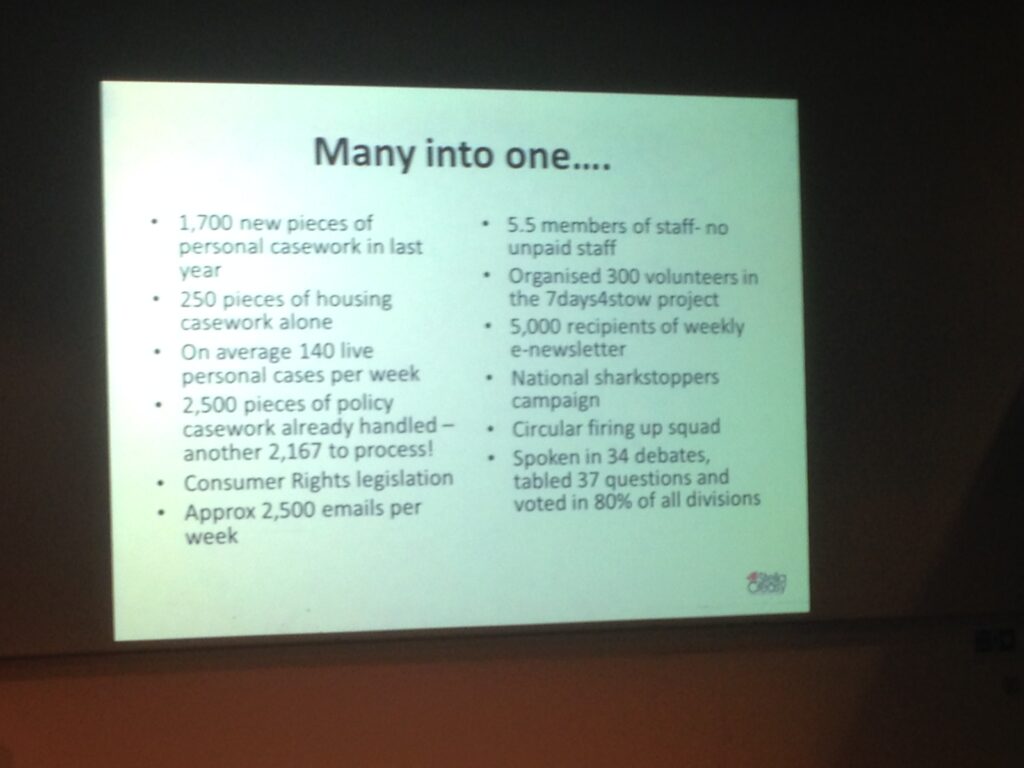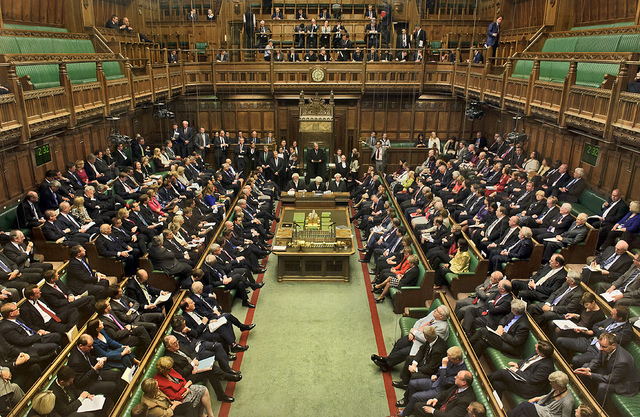It’s a truth, almost universally acknowledged, that MPs don’t like ‘email your MP’ petitions.Listen to MPs talk to campaigners, and they’ll tell you they find the annoying and a burden on precious staff time, but they’re a staple in most campaigning toolkits.
Most MPs will tell you that the volume of emails means it can be hard to distinguished between the signal and the noise? Don’t believe that? While this image is a little out of date (it’s from ECF2014) it was Stella Creasy sharing what, on average, comes into her inbox during a week in Parliament;

Now, I’m not suggesting that we should head calls from some MPs to stop petitioning them – they’re our elected officials so we should petition them. I’m also realistic that any ‘cross Parliament’ solution is unlikely to be adopted – MPs they say, have to be seen as 650 small businesses, so rarely do they all-adopt the same technology, unless they’re told to.
Plus I’m not going to dive into a debate about the quality of some campaigns, except to add that some email to MP campaigns don’t appear to have thought about what the theory of change is – and that has an impact all of us (all campaigners should read this on what makes an effective petition).
So what could replace them in our toolkit? Or if not replace improve how we use them?
1. Phone calls – Unlike the United States we don’t have much of a culture of calling your elected official – perhaps it’ll catch on? Even then it will still be likely to frustrate MPs as much as emails do as they don’t have the staff capacity to deal with the calls, or effective mechanisms to collect the information from them.
2. Parliament petition site – I’ve suggested before that the frustration of MPs could be channelled towards suggesting that they’ll only accept petitions via the official Parliament petition site. While the site has been improved, it still has lots of limitations – not least when it comes to supporter data which is held just by Parliament, that it’s a closed site (so it can’t be embedded on another website) and doesn’t allow for any personalisation by the signer.
3. Focus on a specific MP rather than all MPs – At the NCVO Campaigning Conference, Jess Phillips MP suggested that one of the most effective petitions she’d seen during her time in Parliament had been the change.org petition on the Tampon Tax, which had worked directly with Paula Sherriff MP to help to provide her with the evidence of support for the issue. Strikes me that most issues can find a Parliamentary champion or two, so perhaps this is a way forward?
4. Require your own message – MPs complain that too many emails are identikit, but while many of us try to persuade supporters to personalise the messages they send, have we tested what the drop off would be if we required supporters to come up with their own subject lines, or add in a reason why your signing? It wouldn’t solve the volume question, but could mean that MPs couldn’t accuse of us of just sending ‘identikit’ messages.
5. Better integration with casework software – many MPs who have large amounts of casework use software to track the requests that are coming in from constituents. How many of us are looking to see how we can incorporate our actions and messages into these?
6. Email to letter – Given I have an app on my phone that can turn my photos into a personalised postcard that can be sent in the post to a friend, could the same technology be developed to turn my email to an MP into a letter. It’d place a cost on the organisation behind the campaign, but it’d present the opportunity for delivery via another channel.
7. Snapchat – I can’t pretend to understand Snapchat – which probably means most MPs won’t either) but opportunities do new communication channels like Snapchat or WhatsApp provide new ways to communicate with MPs?
8. Bots – Florian from MoreOnion wonders here if the rise in the use of AI means that we’ll be able to design bots that will be able to automatically capture and engage in a campaign action – could that help MPs respond to our requests.
I’m sure other solutions exist , as well as examples of where petitions are having an impact – in the same presentations that I took that image from Stella Creasy talked about the importance of ensuring a petition is part of wider advocacy strategy – she specifically mentioned Friends of the Earth Bee campaign.
Either way what strikes me from the list above is that organisations have to be prepared to adapt and change rather than just defaulting to ’email your MP’. I look forward to hearing thoughts from others of how we make this tool work to have the maximum impact.
Tag: petition
Future of No10 petition site kicked into long grass….again!
So Martha Lane Fox has today delivered her review of digital provision in central government and the future of the No10 petition site still remains unclear.

The site, which has seen 5 millions people take action, was taken down ahead of the May general election, and ever since its future has remained uncertain (I’ve argued this might not be a bad thing but it’d be good to know one way or another). For the last few weeks it has displayed the following message;
November 2010 – The overall future of all HMG digital comms and engagement is bound into the Martha Lane Fox review, which will be announced imminently. The future of e-petitions will be part of that review.
But a decision is going to be hard when the report which was released today says nothing about the site, e-petitions or how the government can use digital media to engage directly with citizens on public policy issues.
I might be missing something (another report from Lane Fox perhaps), but it seems that the Coalition Government is keen to continue to kick the future of the site into the long grass.
So much for a ‘new way of doing politics’.
Why I'll be pleased to see the end of the No10 petition site
Third Sector PR is reporting on twitter that the No10 petition site might be a casualty of the new administration. The site, was set up in 2006, and is perhaps best remember for the million plus people who signed a petition about road tax. The creators MySociety suggest that over 5 million unique e-mail addresses have used the site since its inception, but I’d be pleased to see the end of the site.
Why?
One. Because I think it’s encouraged lazy campaigning. I’ve only once been involved in trying to encourage people to sign a No10 petition (and despite a huge effort we got about 2,000 names), but it seems that often it was an easy way to tick the ‘we’ve done something to target No10 box’. Good campaigning needs to be about thinking about the most effective target and then the most innovate way of reaching them. To think creatively about how you could get the issue to the attention of the right people within government. For some campaigning NGOs the petition site seemed to put a stop to that.
While I can understand the argument that when it was launched in 2006 it was a way of enabling and empowering anyone to raise an issue of concern, the sheer volume of petitions suggests that only those with a mechanism for broadcasting their idea succeeded. Campaigning has moved on and I think the recent examples of spontaneous, decentralised campaigns on twitter show that there are other tools for doing this.
I don’t think that many (any) policies were changed thanks to the petition site, and too many of them seemed to be a reaction to what was in the Daily Mail (close the Mega Mosque, save the Red Arrows funding, etc) on a particular day.
Two. Because I think it led to lazy engagement from the government with civil society. I understand that their were some guidelines about when No10 would respond to a petition, i.e. if it got over a certain number of actions, but placing numerical limits that are required to be met before enabling a response are very arbitrary. It felt that too often the site was a place for people with concerns to directed to and then forgotten.
My hope is that any review of the petition site leads to a better solution for how No10 will engage with e-campaigns. A proper e-mail address for the PM would help those with embedded campaign tools, while No10 thinking about how it’ll engage with campaigns that appear on a range of platforms (like twitter) would show that they’re following trends in the way people want to communicate with their government.
